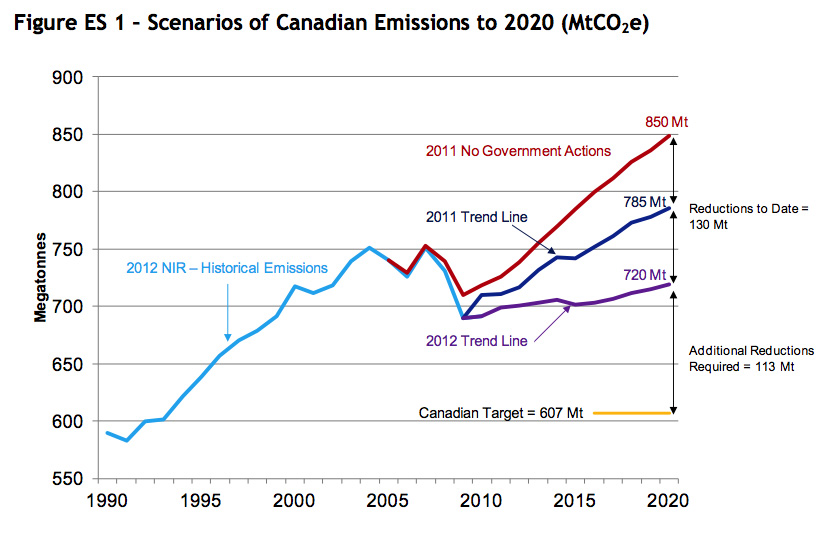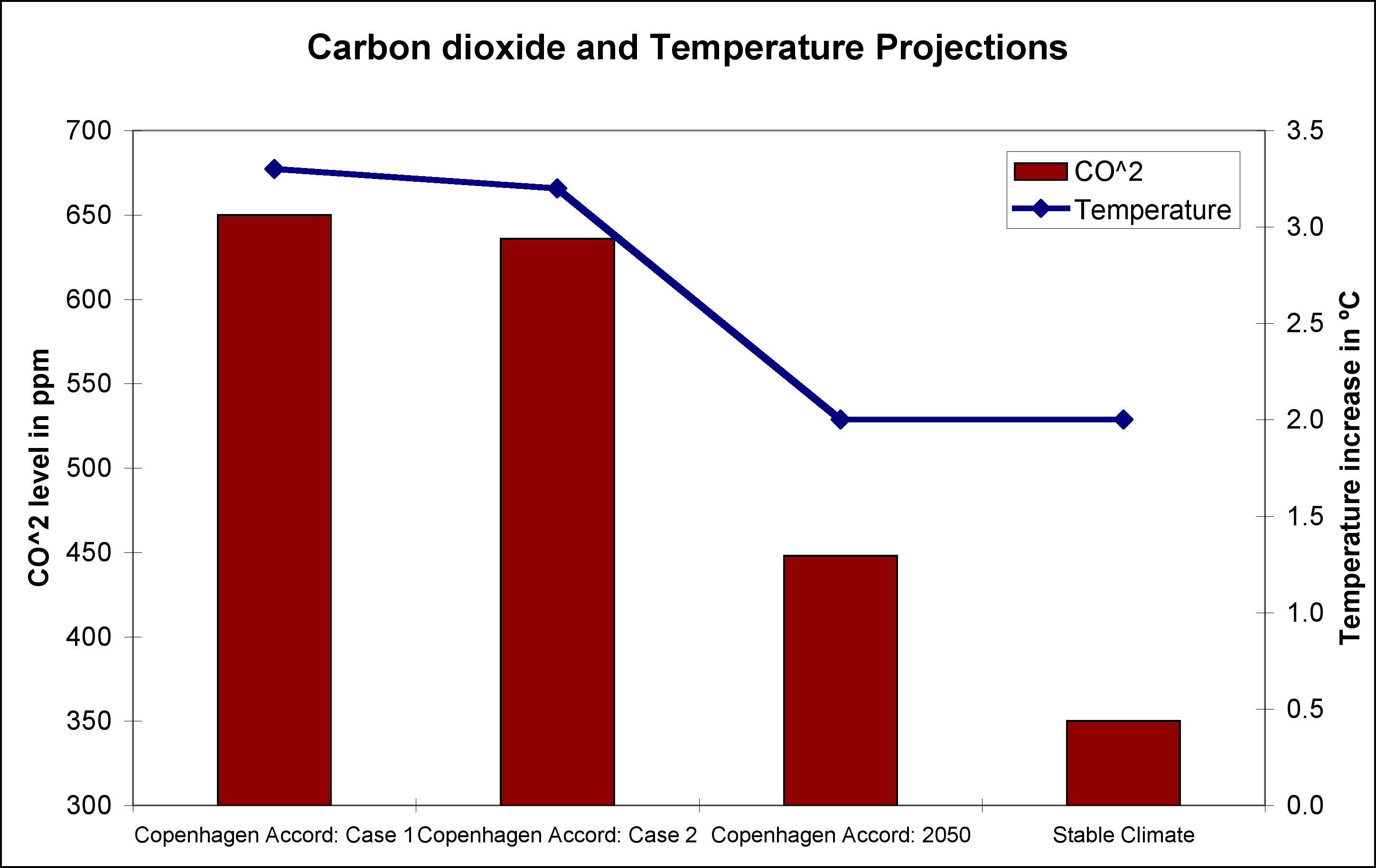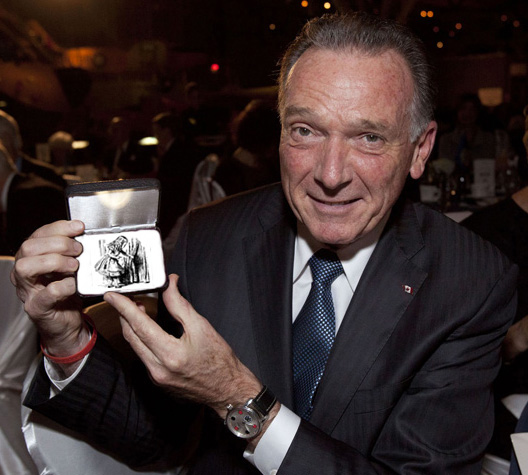“If I had a world of my own, everything would be nonsense. Nothing would be what it is because everything would be what it isn’t. And contrary-wise; what it is it wouldn’t be, and what it wouldn’t be, it would. You see?” — Alice in Wonderland
On August 8, 2012, in a speech at the Algonquin Centre for Construction Excellence in Ottawa, Environment Minister Peter Kent delivered some startling environmental news:
“According to the report [Canada’s Emission’s Trends 2012], Canada is now half way to its target of reducing total greenhouse gas emissions by 17 percent from 2005 levels by 2020. This is the result of the Harper Government’s realistic, sector-by-sector approach to greenhouse gas regulations that is reducing emissions, while continuing to create jobs and encouraging economic growth. Last year, we were one-quarter of the way to our goal. And now we’re half way there. This shows the significant progress we are making in meeting our Copenhagen commitment.”
This sound like great news. It’s 2012 and Canada is already 50 per cent of the way to meeting our greenhouse gas (GHG) reduction targets established in December 2009 when Canada signed the Copenhagen Accord. Time to break out the champagne! Only two and a half years have passed and we’ve already achieved so much — it simply fires the imagination. Let’s rally behind the successful work of the Harper Government so that, as Minister Kent exhorts us to, “we need everyone to stay on board so we can close the gap, and reach our ultimate goal.”
Curb your enthusiasm.
A closer analysis of Kent’s announcement reveals that these purported emissions reductions are bogus from start to finish.
Carbon through the looking glass
 “It would be so nice if something would make sense for a change.” — Alice in Wonderland
“It would be so nice if something would make sense for a change.” — Alice in Wonderland
Setting aside for a moment the question of whether emissions targets under the Copenhagen Accord have any meaning or consequence whatsoever, what exactly are we halfway to?
As part of the Copenhagen Accord, Canada committed to reducing total greenhouse gas emissions 17 per cent from 2005 levels by 2020. In 2005 Canada’s GHG emissions were 740 Megatons of Carbon dioxide equivalent (MtCO^2eq; abbreviated hereafter as Mt). Seventeen per cent of this is 126 Mt and half of that is 63 Mt, so if we are 50 per cent of the way there, Canada’s GHG emissions should be 667 Mt, right? Wrong.
What are Canada’s GHG emissions? According to the National Inventory Report 1990-2010: Greenhouse Gas Sources and Sinks in Canada (NIR) emissions in 2010 (the most recent year for which data is available) were 692 Mt. So this would indicate that we are 38 per cent of the way there, although even that might be generous, since the original calculations for Canada’s 2010 GHG emissions were 710 Mt but a “re-assessment” under the NIR puts them at 692 Mt instead.
There’s also some sleight of hand from Environment Canada since, although Canada’s 2005 GHG emissions were 740 Mt, Canada’s commitment for a 17 per cent reduction is not based on this figure but rather the figure of 731 Mt from the 2011 NIR (thus, a reduction of 124.3 Mt), but let’s not quibble about 1.5 Mt of carbon dioxide more or less. On that basis (which is what the federal government is using), a reduction of 17 per cent is 607 Mt. If we’re starting from 731 Mt, and we need to reduce GHG emissions to 607 Mt, and we are presently at 692 (i.e., 39 MT less), then we have achieved a 31 per cent reduction. So how can Environment Minister Peter Kent claim we are half way to our target? Simple! Environment Canada made it up for him.
Figure ES 1 (below) from the Emissions Trends report is a spectacular illustration of Alice through the looking glass science. Emissions reductions are not indicated in relation to what current emissions actually are but to what projections of what it is hoped they will be in 2020. The levels in 2020 are an important future objective, but these targets are aspirational and should not be used as an indication of what he have actually achieved. However, an even more spectacular excursion into fantasyland is the red line called “No government actions” leading to emissions of 850 Mt in 2020. How did the government determine this information? Answer: it simply made it up. There is no indication of the methodology or assumptions that underlie this, and such a concept in principle lends itself to pulling arbitrary figures out of the hypothetical hat.

This concocted “no government actions” figure — made up without any indication of methodology or assumptions — allows Peter Kent to say that since 720 Mt is halfway between 607 Mt (the objective) and 850 Mt (the fantasy figure) we have therefore achieved a 50 per cent reduction (actually a 53 per cent if you do the arithmetic correctly). Presto, and it’s done! This is the equivalent of saying that we have already won 50 per cent of the medals we are planning to win at the 2020 Olympics — and just about as meaningful.
This is a spectacularly stupid manipulation of statistics that would get a failing grade in any sophomore statistics or environmental sciences class. The fact that Environment Canada appears party to such smoke and mirrors science raises serious questions about how a Canadian government department could or would be suborned into such a deception that has nothing to do with science and everything to do with promulgating a disingenuous happy-happy Harper Government agenda.
However, even if we drink this Kool-Aid, what is Canada actually on-track to achieve? Emissions of 720 Mt in 2020. This is 98.5 percent of the 731 Mt emissions in 2005, in other words, a 1.5 per cent reduction in emissions rather than the 17 per cent that Canada has pledged under the Copenhagen Accord. So even aspirationally we are only on track to achieve 9 per cent of our Copenhagen target by 2020. How will we make up the remaining 91 per cent? Amorphously Kent says, “Canada will continue to work with its partners to address the remaining major sources of emissions,” something that should certainly give all of us confidence.
Passing Gas
 “‘I can’t believe that!’ said Alice. ‘Can’t you?’ the Queen said in a pitying tone. ‘Try again.'” — Lewis Carroll
“‘I can’t believe that!’ said Alice. ‘Can’t you?’ the Queen said in a pitying tone. ‘Try again.'” — Lewis Carroll
The larger question, however, is does any of this even mean anything of substance? A detailed analysis of the implications of the Copenhagen Accord entitled Analysis of the Copenhagen Accord pledges and its global climatic impacts — a snapshot of dissonant ambitions was undertaken by a group of ten climatologists lead by Joeri Rogelj of the Potsdam Institute for Climate Impact Research. There are innumerable variables in undertaking such an analysis (only 85 of the 193 participating countries had submitted pledges for their reduction targets), however, the authors developed two possible cases of temperature and carbon dioxide outcomes for 2020. In the first case, levels of carbon dioxide would increase to 650 ppm (parts per million) and temperatures would rise 3.3 ºC above pre-industrial levels (a range of 2.5-4.2 ºC). In the second case levels of carbon dioxide would increase to 636 ppm and temperatures would rise 3.2 ºC (a range of 2.4-4.1 ºC). In both cases the probability that temperature increases would exceed 2.0 ºC are greater than 99 per cent.

These levels are significant since many climatologists believe that a 2.0 ºC increase is a critical threshold beyond which runaway and potentially unstoppable climate change is possible. The Copenhagen Accord itself says that its objective is to hold global temperature increases to below 2.0 ºC so as to prevent “dangerous anthropogenic interference with the climate system.” Indeed, 1.5 ºC is viewed by many climatologists and the Accord itself as the more desirable long-term objective. Even extending their analysis to 2050 with optimistic levels of GHG reductions (there are even no voluntary targets in place for beyond 2020), Rogelj and his colleagues still projected that carbon dioxide levels would be at 448 ppm and temperatures would be 2.0 ºC above pre-industrial levels (a range of 1.5-2.6 ºC) and the probability of exceeding 1.5 ºC is 93 per cent. Furthermore, as the authors point out, the Accord is not legally binding and “parties can add, modify or withdraw their submitted pledges or actions without any restriction.” With understatement they conclude:
“If the average national ambition level for 2020 is not substantially improved and loopholes closed in the continued negotiations, only low probability options remain for reaching the 2 ºC (and possible 1.5 ºC) ambition of the Accord.”
It’s also important to bear in mind that NASA climatologist James Hansen has determined that 350 ppm is the safe upper limit for atmospheric carbon dioxide (the reason that environmentalist Bill McKibben has called his advocacy organization 350.org). So, environmental strategies that have no binding status, rely solely on voluntary targets, which take the world to carbon dioxide levels exceeding 600 ppm, and which result in global temperature increases of more than 3.2 ºC are exercises in public relations, futility, and incipient disaster.
For the sake of comparison, under the Kyoto Protocol (which Canada has now formally withdrawn from), Canada had committed to reducing GHG emissions 6 per cent below 1990 levels by 2012. In 1990 GHG emissions in Canada were 589 Mt so 6 per cent reduction would lower this to 554 Mt. On that basis the 2010 level of emissions of 692 Mt is 17.5 per cent above 1990 levels and 25 per cent above where Canada said we would be in our Kyoto undertakings (which were legally binding).
These aren’t the only problems with both the Emissions Trend Report and Mister Kent’s cheerful gloss on it. In Canada’s Emissions Deception, published by the Canadian Centre for Policy Alternatives, economist Marc Lee points out that the projected goal of 720 Mt in 2020 is suspect. Subtract some questionable economic and land use assumptions that the report makes and the more probably trend-line of carbon emissions is 754 Mt by 2020, a 3 per cent increase above 2005 levels.
 Beyond that, even what reductions have and will be made are largely at the behest of provincial governments, namely British Columbia’s carbon-tax, Quebec’s cap and trade system, and Ontario’s complete phase-out of coal-fired electricity generation by the end of 2014. As P.J. Partington, a policy analyst with the Pembina Institute, writes in an article entitled Are we there yet? Closing the gap on Canada’s climate commitments, “Canada remains wildly off course for meeting its target and the federal government still has not shown how it will address this. The government’s plodding sector-by-sector approach simply will not deliver the necessary cuts to emissions within the time frame required.”
Beyond that, even what reductions have and will be made are largely at the behest of provincial governments, namely British Columbia’s carbon-tax, Quebec’s cap and trade system, and Ontario’s complete phase-out of coal-fired electricity generation by the end of 2014. As P.J. Partington, a policy analyst with the Pembina Institute, writes in an article entitled Are we there yet? Closing the gap on Canada’s climate commitments, “Canada remains wildly off course for meeting its target and the federal government still has not shown how it will address this. The government’s plodding sector-by-sector approach simply will not deliver the necessary cuts to emissions within the time frame required.”
Therefore Peter Kent’s assertion that “This is the result of the Harper Government’s realistic, sector-by-sector approach to greenhouse gas regulations that is reducing emissions …” is just blowing smoke. While the federal government continues to download costs onto the provinces and eviscerates Environment Canada’s (and every other Canadian agency’s) capacity to undertake research, monitoring, and remediation in relation to climate change, Kent wants to claim credit for a success that doesn’t exist. Kent is simply passing gas onto the next generation to deal with. Each passing day indicates that carbon dioxide my prove as toxic to the next generation as mustard gas was to a previous one.
“‘I daresay you haven’t had much practice’’ said the Queen. ‘Why, sometimes I’ve believed as many as six impossible things before breakfast.'” — Lewis Carroll
P.S. Climate scientist Thomas Duck has also recently investigated Peter Kent’s bogus climate change assertions in an article for The Mark entitled Telling Harper what he want to hear. Duck highlights how both the scientific best practices for forecasting emissions projections, and emissions projections themselves established by the National Round Table on the Environment and the Economy (NRTEE) have been abandoned in Canada’s Emissions Trends 2012 report. Is it coincidental that NTREE itself is being terminated by the Harper Government? As to the practices followed in the report, Duck writes, “Outside of government, cooking the books like this is considered fraud.”
Christopher Majka is an ecologist, environmentalist, policy analyst, and writer. He is the director of Natural History Resources and Democracy: Vox Populi.



